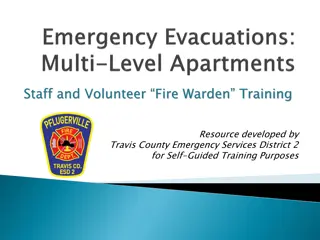Australia on Fire: Climate Crisis and Wildfires Threatening the Continent
Australia is experiencing devastating wildfires fueled by factors like lack of rainfall, prolonged drought, and climate change. Record-breaking temperatures and minimal rainfall have exacerbated the situation. The fires, which started earlier than usual, have spread across states like NSW, Queensland, and Victoria, posing significant challenges. The environmental impact, including dangerous smoke and lightning strikes, underscores the urgent need for action in combating this crisis.
Download Presentation

Please find below an Image/Link to download the presentation.
The content on the website is provided AS IS for your information and personal use only. It may not be sold, licensed, or shared on other websites without obtaining consent from the author.If you encounter any issues during the download, it is possible that the publisher has removed the file from their server.
You are allowed to download the files provided on this website for personal or commercial use, subject to the condition that they are used lawfully. All files are the property of their respective owners.
The content on the website is provided AS IS for your information and personal use only. It may not be sold, licensed, or shared on other websites without obtaining consent from the author.
E N D
Presentation Transcript
AUSTRALIA ON FIRE Presented by: Spencer McIntosh Charlotte McIntosh Poppy McIntosh
AUSTRALIA ON FIRE THE FACTS The hottest months in Australia are December, January and February. Opposite to Europe. According to the Bureau of Meterology, on December 18th, Australia recorded its hottest day on record with an average maximum across the country of 41.9 degrees celcius. The average maximum temperature in Australia, for the whole year of 2019, was 30.7 degrees celsius. Imagine every day of the year reaching nearly 31 degrees! Temperatures as high as 49.9 degrees celsius were recorded last Thursday in South Australia.
AUSTRALIA ON FIRE Australia s total rainfall in 2019 was only 277 millimetres, the lowest since records began in 1900, and about 40 per cent below average. The average rainfall in the UK is 885 millimetres. It rained less than 1/3 the amount in Australia as it does in the UK on average. Australia is about 32 times bigger than United Kingdom. Therefore, Australia had a lot less rain to share across a significantly larger land mass, making Australia a very dry country.
AUSTRALIA ON FIRE The map on the right shows the relative size of The British Isles, sitting within Australia. Australia had less than a third of UK s average rainfall in 2019.
AUSTRALIA ON FIRE We know that the fires are fuelled by: a lack of rainfall, lengthy drought, low humidity, fiercely strong winds, and climate change. The first fires sparked in September 2019, which is one month earlier than the official fire-danger season. The danger season officially begins in October and runs through to March, so we sadly have a lot of worrying times ahead of us. In NSW, Queensland, and my own home state of Victoria, fires raged by November. The smoke from the fires, generate dangerous clouds that create wind, thunderstorms and lightning - a volatile combination. When lightning hits the trees, it ignites more fires.
AUSTRALIA ON FIRE The billowing smoke throws fine matter into the air. The air Australians are breathing is equivalent to smoking 37 cigarettes a day. When inhaled, it causes inflammation and damage to the lungs. Sydney and Melbourne are currently classed as the World s most polluted cities, at this snapshot in time. Some smoke has made it all the way to South America, which is over 16,000 kms away from Australia. The smoke has travelled to our neighbours, and is turning the glaciers in New Zealand brown.
AUSTRALIA ON FIRE Thousands of Australians were reported to have evacuated their homes on New Years Eve. I don t think that would have been a very fun way to spend New Years Eve! To date, the fires have burnt an area of 17.9 million acres across 6 states in Australia, an area the size of Scotland. This is difficult to visualise, so here is a diagram with reference to England:
AUSTRALIA ON FIRE The total area of land affected by fires in New South Wales alone, would cover most of Southern England.
AUSTRALIA ON FIRE Devastatingly, at this present moment, Australia has lost: 2000 homes 25,000 koalas an estimated 1 billion wildlife animals in total 27 human lives so far Current cost of damages has reached 370 million, and will rise significantly.
AUSTRALIA ON FIRE The fires are still alive, and not showing any signs of stopping, with the hottest part of Summer still to follow. Currently in our home state of Victoria, areas have been classed as disaster zones and people are being told to leave as we speak. My family personally, live in a built up city in Central Victoria, called Bendigo. Our family are very fortunate to have escaped the embers of fire. However, within a close 5 km radius, surrounding bushland areas were on high alert, ready to evacuate. It has been very scary times for everyone at home! We really appreciate you listening to our pleas, and we hope you might be able to support the families and animals affected by these terrible fires. Here is short video of our home country.
AUSTRALIA ON FIRE tribute
AUSTRALIA ON FIRE One last thing I would like us all to ponder, please may we make green decisions to STOP Global Warming. THANK YOU SO MUCH FOR LISTENING.























